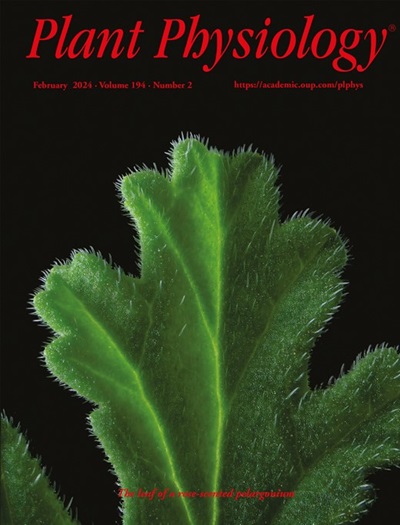跨长链戊烯基二磷酸合成酶促进葡萄中泛醌10的生物合成。
IF 6.9
1区 生物学
Q1 PLANT SCIENCES
引用次数: 0
摘要
戊烯基二磷酸合成酶(PDS)在萜烯生物合成中起着不可缺少的作用。然而,关于葡萄(Vitis vinifera)香叶基二磷酸合成酶(VvGDS, VIT_15s0024g00850)是否能产生单萜生物合成的前体香叶基二磷酸(GPP),一直存在争议。在这里,我们证明了VvGDS定位于线粒体,是一种真正的跨长链戊烯基二磷酸合成酶(因此,VvGDS被重新命名为VvPDS),它是泛素(UQ)生物合成所必需的。这一发现与VvPDS与单萜生物合成相关的GDS活性的最初关联相反。VvPDS不仅属于参与其他真核生物UQ10生物合成的线粒体反长链pds亚群,而且与葡萄不同组织中UQ10含量呈正相关。VvPDS不能催化以二磷酸异戊烯基(IPP)和二磷酸二甲基烯丙基(DMAPP)为底物的GPP生物合成。此外,VvPDS在功能上补充了缺乏线粒体六烯丙烯二磷酸合成酶活性的酵母coq1突变,并催化了UQ10和UQ9的生物合成。葡萄叶片中瞬时过表达VvPDS增加了UQ10的积累,而沉默VvPDS导致UQ10含量明显降低。同样,VvPDS的稳定过表达增强了烟草(Nicotiana tabacum)中UQ10的积累,这些UQ10过量产生的植物主要通过增强活性氧清除能力表现出更高的氧化胁迫耐受性。综上所述,这些发现为支持葡萄中UQ的生物合成提供了生化和遗传学证据,并鼓励未来的研究重新评估被子植物pds的酶功能和生理作用。本文章由计算机程序翻译,如有差异,请以英文原文为准。
A trans-long-chain prenyl diphosphate synthase promotes ubiquinone 10 biosynthesis in grape.
Prenyl diphosphate synthase (PDS) plays indispensable roles in terpene biosynthesis. However, there is an ongoing debate regarding whether grape (Vitis vinifera) geranyl diphosphate synthase (VvGDS, VIT_15s0024g00850) can generate geranyl diphosphate (GPP), the precursor of monoterpene biosynthesis. Here, we demonstrated that VvGDS localizes in mitochondria and is an authentic trans-long-chain prenyl diphosphate synthase (thus, VvGDS was renamed VvPDS), which is essential for ubiquinone (UQ) biosynthesis. This finding is in contrast to the initial association of VvPDS with GDS activity related to monoterpene biosynthesis. VvPDS not only falls within the subgroup comprising mitochondrial trans-long-chain PDSs, which participate in UQ biosynthesis in other eukaryotes, but also exhibits a positive association with UQ10 content in different grape tissues. VvPDS cannot catalyze GPP biosynthesis using isopentenyl diphosphate (IPP) and dimethylallyl diphosphate (DMAPP) as substrates. Furthermore, VvPDS functionally complements the yeast coq1 mutation lacking mitochondrial hexaprenyl diphosphate synthase activity and catalyzes UQ10 and UQ9 biosynthesis. Transient overexpression of VvPDS in grape leaves increased UQ10 accumulation, whereas silencing VvPDS caused an obvious reduction in UQ10 content. Similarly, the stable overexpression of VvPDS enhanced UQ10 accumulation in tobacco (Nicotiana tabacum), and these UQ10-overproducing plants exhibited improved oxidative stress tolerance, primarily through enhanced reactive oxygen species-scavenging capacity. Taken together, these findings provide biochemical and genetic evidence supporting UQ biosynthesis in grape and encourage future research to reevaluate the enzymatic functions and physiological roles of angiosperm PDSs.
求助全文
通过发布文献求助,成功后即可免费获取论文全文。
去求助
来源期刊

Plant Physiology
生物-植物科学
CiteScore
12.20
自引率
5.40%
发文量
535
审稿时长
2.3 months
期刊介绍:
Plant Physiology® is a distinguished and highly respected journal with a rich history dating back to its establishment in 1926. It stands as a leading international publication in the field of plant biology, covering a comprehensive range of topics from the molecular and structural aspects of plant life to systems biology and ecophysiology. Recognized as the most highly cited journal in plant sciences, Plant Physiology® is a testament to its commitment to excellence and the dissemination of groundbreaking research.
As the official publication of the American Society of Plant Biologists, Plant Physiology® upholds rigorous peer-review standards, ensuring that the scientific community receives the highest quality research. The journal releases 12 issues annually, providing a steady stream of new findings and insights to its readership.
 求助内容:
求助内容: 应助结果提醒方式:
应助结果提醒方式:


